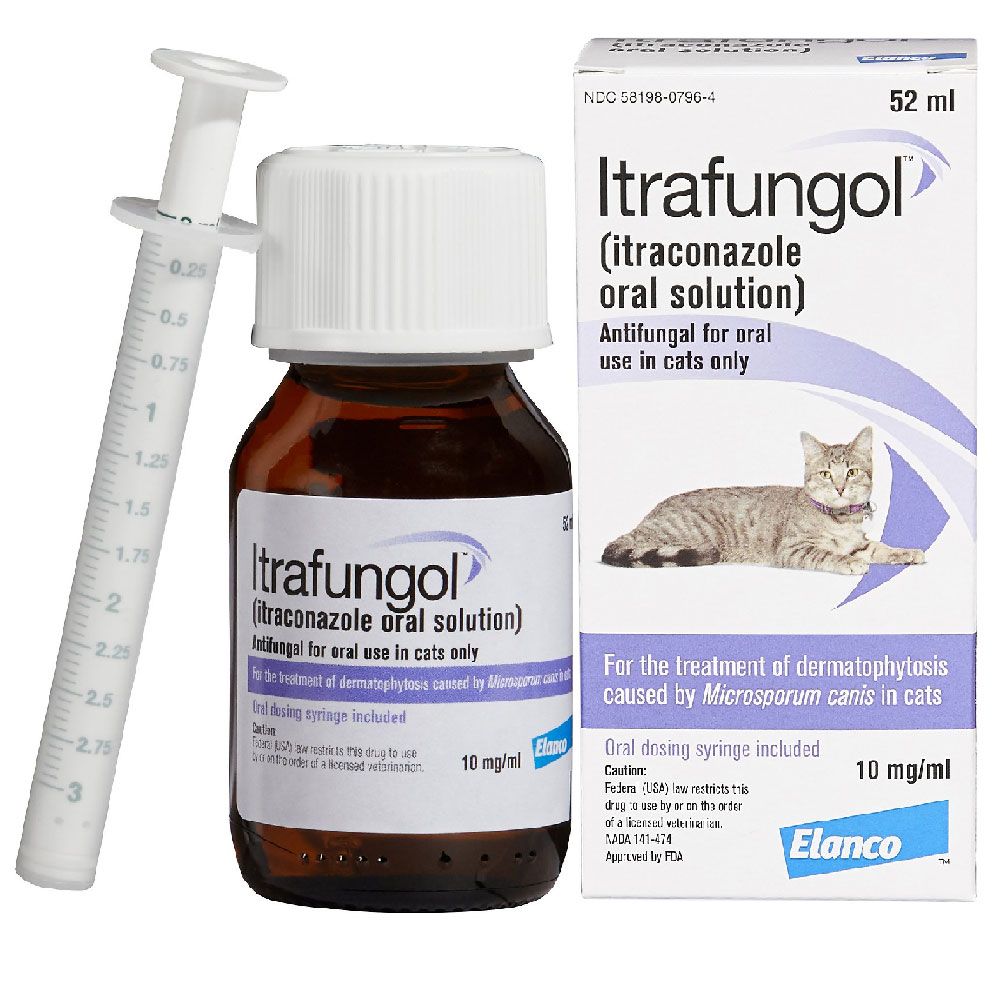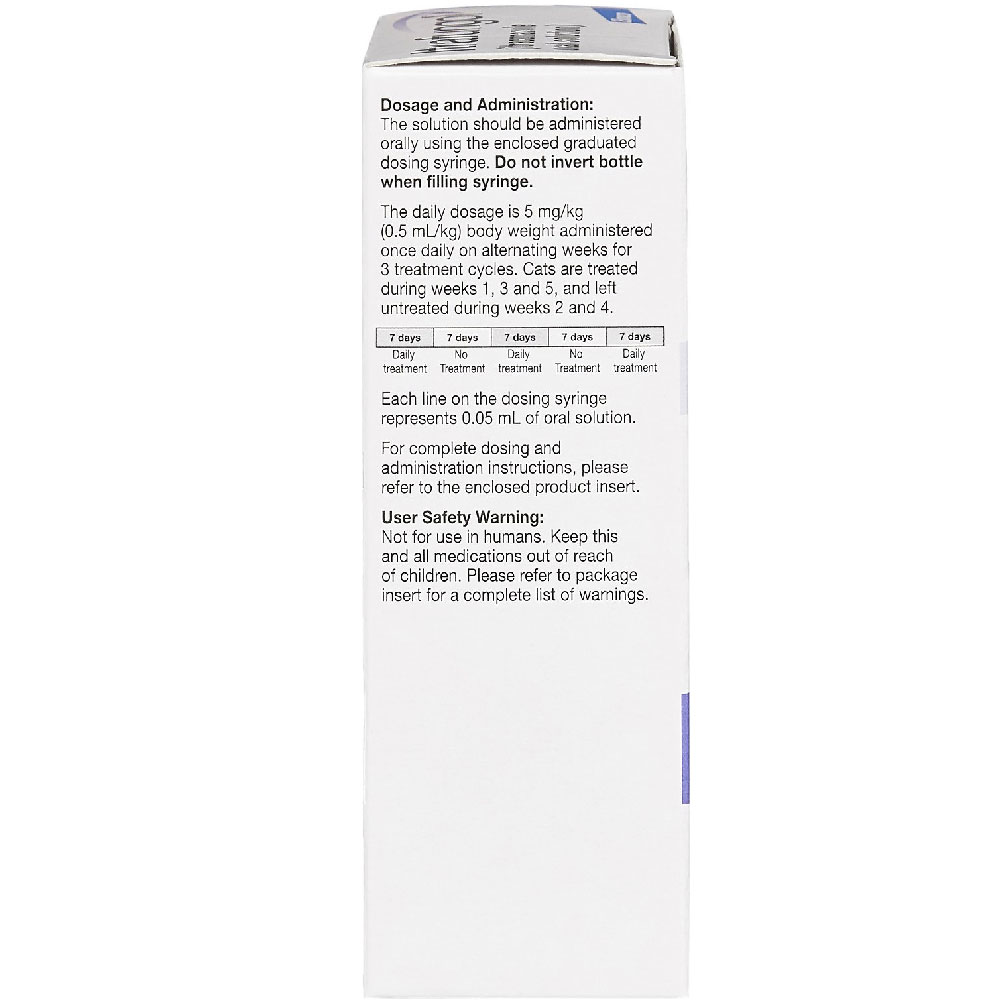Sitewide SALE! GET 15% Off! Use Code EPX15 *
Itrafungol Oral Solution for Cats (52 ml)
- Notice
- Description
- Ingredients
- Directions
- FAQ
- Reviews
Notices
ITRAFUNGOL ON SALE! Discounted price can be seen in cart.
Description
Itrafungol (Itraconazole Oral Solution) is used to treat ringworm in cats caused by a fungus infection. Cats with ringworm typically have patches of hair loss, scaling, crusting, and redness, with or without itchiness. Most skin lesions are found around the ears and face or on the legs. The disease is most commonly seen in kittens.
Itrafungol Use
Itrafungol oral solution is used for treating dermatophytosis caused by Microsporum in cats.
Key Benefits
- Easy to administer with oral dosing syringe
- Delicious with cherry flavor
- Cost-effective
How It Works
Itrafungol is a cherry caramel-flavored liquid that is easy to dose and easy to administer. It requires a short course of pulse therapy oral dosing on alternate weeks for three treatment cycles.
Ingredients
Directions
View Itrafungol package insert for more information
The solution should be administered orally using the graduated dosing syringe.
The daily dosage is 5 mg/kg body weight administered once daily on alternating weeks for 3 treatment cycles. Cats are treated during weeks 1, 3, and 5, and left untreated during weeks 2 and 4.
Dosage Table


Dosage & Administration
- The solution should be administered orally using the enclosed graduated dosing syringe. Keep the bottle upright and insert the dosing syringe through the opening of the top of the bottle (Figure 1).
- DO not invert the bottle (Figure 2).
- Fill the syringe by pulling the plunger until it reaches the graduation corresponding to the correct mL dose as indicated at the top of the syringe ring (Figure 3).
- Treat the cat by slowly and gently administering the liquid into the mouth, allowing the cat to swallow the product (Figure 4).
For cats weighing more than 13.0 lbs, the total dose will need to be calculated and given over two doses as the dosing syringe only holds 3.0 mL of solution.
After dosing, the syringe should be removed from the bottle, rinsed and dried and the bottle cap should be screwed back on tightly.
Storage Directions
Store at 68-77°F (20-25°C). Excursions permitted between 59-86°F (15-30°C). Keep away from children and pets.
Contraindications
Do not administer to cats with hypersensitivity to itraconazole.
Warnings
Itrafungol (itraconazole oral solution) has not been shown to be safe in pregnant cats (see Animal Safety section). Itrafungol should only be used in pregnant or lactating cats when the benefits outweigh the potential risks.
User Safety Warnings
Not for use in humans. Keep this and all medications out of reach of children. Wash hands and exposed skin after use. In case of accidental contact with eyes, rinse thoroughly with water. In case of pain or irritation, seek medical advice. In case of accidental ingestion, rinse mouth with water and seek medical advice.
Special precautions for person administering the veterinary product to the animal:
Microsporum canis dermatophytosis is a zoonotic disease (a disease that can be transmitted from animals to humans); therefore consult a physician if a suspected lesion occurs on a human. Wear protective gloves when handling the animal during treatment or when cleaning the syringe. Wash hands and exposed skin after handling the animal.
Itrafungol has not been shown to be sporicidal; therefore in order to reduce zoonotic potential, environmental contamination, and to decrease course of the disease, topical and environmental treatment should also be utilized.
Precautions
Itrafungol has been associated with renal changes found on histopathology that were not noted after an eight week recovery period (see Animal Safety). Use with caution in cats with renal dysfunction.
Itrafungol is metabolized by the liver (mainly CYP3A) and can cause elevated liver enzymes (see Animal Safety section). Use with caution in cats with impaired liver function. If clinical signs suggestive of liver dysfunction develop, treatment should be discontinued.
Itrafungol is a cytochrome p-450 inhibitor and may increase or prolong plasma concentrations of other drugs metabolized by this pathway, such as amitriptyline, amlodipine, benzodiazepines, buspirone, cisapride, corticosteroids, cyclosporine, ivermectin, and macrolide antibiotics.
Negative effects have been reported in literature when itraconazole was administered intravenously to dogs and healthy human volunteers. Cats suffering from heart disease should be carefully monitored during treatment.
FAQ
Reviews
- Easy to dose
- Starts to work quickly, for most cats
- Expensive!
- Some vets won't prescribe
Examples:
1) This medicine should never be used alone - there always has to be external and internal treatment, or ringworm will return.
2) Dipping/bathing is no longer recommended. Instead, a spray is used, which is less traumatic for the cat and the liquid won’t be contaminated by multiple cats. 2) Bleach is not needed. It’s been well documented that regular laundry detergent and *sufficient* water will eliminate infected fur and spores. Only a culture will tell if a cat is completely cured, and plucking fur is no longer recommended. A more accurate and completely painless method is using a toothbrush. Wear different clothing in rooms with ringworm cats versus healthy cats. Launder clothing and their bedding daily. Mop or vacuum frequently. Please make sure you are getting up-to-date, recent information.
- Assuming you're also using a foam or other external treatment, this medicine works. Internal and external treatment should always be done in tandem. We happen to use a foam three times a week. Our cat doesn't mind the flavor - very mild, slightly cherry.
- 2.75 mls is a lot of medicine (for a 12 pound cat). And the real con? After using the syringe and cleaning it after each use, the action isn?t smooth. Being able to buy other syringes of the same type would be appreciated. Separate syringes our vet gave us do not fit into the grid.
- It is much easier to fight ring worm from the inside rather than the outside. But once it starts working on some cats, you can stop using the topicals and it will do its job.
- It just doesn't work well on all cats. Sometimes you have to use quite a bit of topical solution to get rid of ring worm. I don't think the 1 week on, 1 week off works. But I'm afraid of it building up too much and causing problems with my babies.
A grateful kitten momma













